Processing and Characterization of BCZT-Modified BiFeO3-BaTiO3 Piezoelectric Ceramics
Abstract
:1. Introduction
2. Experimental Procedure
3. Results and Discussion
4. Conclusions
Author Contributions
Funding
Conflicts of Interest
References
- Hao, J.; Li, W.; Zhai, J.; Chen, H. Progress in high-strain perovskite piezoelectric ceramics. Mater. Sci. Eng. R Rep. 2019, 135, 1–57. [Google Scholar] [CrossRef]
- Zheng, T.; Wu, J.; Xiao, D.; Zhu, J. Recent development in lead-free perovskite piezoelectric bulk materials. Prog. Mater. Sci. 2018, 98, 552–624. [Google Scholar] [CrossRef]
- Malik, R.A.; Hussain, A.; Zaman, A.; Maqbool, A.; Rahman, J.U.; Song, T.K.; Kim, W.J.; Kim, M.H. Structure–property relationship in lead-free A-and B-site co-doped Bi0.5 (Na0.84K0.16)0.5 TiO3–SrTiO3 incipient piezoceramics. RSC Adv. 2015, 5, 96953–96964. [Google Scholar] [CrossRef]
- Rödel, J.; Webber, K.G.; Dittmer, R.; Jo, W.; Kimura, M.; Damjanovic, D. Transferring lead-free piezoelectric ceramics into application. J. Eur. Ceram. Soc. 2015, 35, 1659–1681. [Google Scholar] [CrossRef]
- Zeeshan; Panigrahi, B.K.; Ahmed, R.; Mehmood, M.U.; Park, J.C.; Kim, Y.; Chun, W. Operation of a low-temperature differential heat engine for power generation via hybrid nanogenerators. Appl. Energy 2021, 285, 116385. [Google Scholar] [CrossRef]
- Hajra, S.; Tripathy, A.; Panigrahi, B.K.; Choudhary, R.N.P. Development and excitation performance of lead-free electronic material: Eu and Fe doped Bi0.5Na0.5TiO3 for filter application. Mater. Res. Express 2019, 6, 076304. [Google Scholar] [CrossRef]
- Hajra, S.; Sahoo, S.; Mishra, T.; De, M.; Rout, P.K.; Choudhary, R.N.P. Studies of structural, dielectric and electrical characteristics of BaTiO3–BiFeO3–CaSnO3 electronic system. J. Mater. Sci. Mater. Electron. 2018, 29, 7876–7884. [Google Scholar] [CrossRef]
- Briscoe, J.; Dunn, S. Piezoelectric nanogenerators—A review of nano structured piezoelectric energy harvesters. Nano Energy 2015, 14, 15–29. [Google Scholar] [CrossRef]
- Hanani, Z.; Izanzar, I.; Amjoud, M.; Mezzane, D.; Lahcini, M.; Ursic, H.; Prah, U.; Saadoune, I.; Marssi, M.E.; Lukyanchuk, I.A.; et al. Lead-free nanocomposite piezoelectric nanogenerator film for biomechanical energy harvesting. Nano Energy 2021, 81, 105661. [Google Scholar] [CrossRef]
- Mistewicz, K. Recent advances in ferroelectric nanosensors: Toward sensitive detection of gas, mechanothermal signals, and radiation. J. Nanomater. 2018, 2018, 2651056. [Google Scholar] [CrossRef]
- Lee, H.S.; Chung, J.; Hwang, G.T.; Jeong, C.K.; Jung, Y.; Kwak, J.H.; Kang, H.; Byun, M.; Kim, W.D.; Hur, S.; et al. Flexible inorganic piezoelectric acoustic nanosensors for biomimetic artificial hair cells. Adv. Funct. Mater. 2014, 24, 6914–6921. [Google Scholar] [CrossRef]
- Qian, W.; Yang, W.; Zhang, Y.; Bowen, C.R.; Yang, Y. Piezoelectric materials for controlling electro-chemical processes. Nano-Micro Lett. 2020, 12, 149. [Google Scholar] [CrossRef]
- Mistewicz, K.; Kepinska, M.; Nowak, M.; Sasiela, A.; Zubko, M.; Stróz, D. Fast and efficient piezo/photocatalytic removal of methyl orange using SbSI nanowires. Materials 2020, 13, 4803. [Google Scholar] [CrossRef]
- Adnan, M.; Hussain, A.; Rahman, J.U.; Malik, R.A.; Song, T.K.; Kim, M.-H.; Kim, W.-J. Composition-dependent structural, dielectric and ferroelectric responses of lead-free Bi0.5Na0.5TiO3-SrZrO3 ceramics. J. Korean Phys. Soc. 2016, 68, 1430–1438. [Google Scholar]
- Rahman, J.U.; Hussain, A.; Adnan, M.; Malik, R.A.; Song, T.K.; Kim, M.-H.; Lee, S.; Kim, W.-J. Effect of donor doping on the ferroelectric and the piezoelectric properties of lead-free 0.97(Bi0.5Na0.5Ti1−xNbx)O3-0.03BaZrO3 ceramics. J. Korean Phys. Soc. 2015, 67, 1240–1245. [Google Scholar] [CrossRef]
- Rahman, J.U.; Hussain, A.; Adnan, M.; Malik, R.A.; Kim, M.S.; Kim, M.-H. Effect of sintering temperature on the electromechanical properties of 0.945Bi0.5Na0.5TiO3-0.055BaZrO3 ceramics. J. Korean Phys. Soc. 2015, 66, 1072–1076. [Google Scholar] [CrossRef]
- Cheon, C.I.; Choi, J.H.; Kim, J.S.; Zang, J.; Fromling, T.; Rodel, J.; Jo, W. Role of (Bi1/2K1/2) TiO3 in the dielectric relaxations of BiFeO3-(Bi1/2K1/2) TiO3 ceramics. J. Appl. Phys. 2016, 119, 15410. [Google Scholar] [CrossRef]
- Ryu, G.H.; Hussain, A.; Lee, M.H.; Malik, R.A.; Song, T.K.; Kim, W.J.; Kim, M.H. Lead-free high performance Bi (Zn0.5Ti0.5) O3-modified BiFeO3-BaTiO3 piezoceramics. J. Eur. Ceram. Soc. 2018, 38, 4414–4421. [Google Scholar] [CrossRef]
- Lee, M.H.; Kim, D.J.; Park, J.S.; Kim, S.W.; Song, T.K.; Kim, M.H.; Kim, W.J.; Do, D.; Jeong, I.K. High-performance lead-free piezoceramics with high curie temperatures. Adv. Mater. 2015, 27, 6976–6982. [Google Scholar] [CrossRef] [PubMed]
- Rojac, T.; Bencan, A.; Malic, B.; Tutuncu, G.; Jones, J.L.; Daniels, J.E.; Damjanovic, D. BiFeO3 ceramics: Processing, electrical, and electromechanical properties. J. Am. Ceram. Soc. 2014, 97, 1993–2011. [Google Scholar] [CrossRef]
- Khan, S.A.; Ahmed, T.; Akram, F.; Bae, J.; Choi, S.Y.; Thanh, T.T.; Kim, M.; Song, T.K.; Sung, Y.S.; Kim, M.H.; et al. Effect of sintering temperature on the electrical properties of pristine BF-35BT piezoelectric ceramics. J. Korean Ceram. Soc. 2020, 57, 290–295. [Google Scholar] [CrossRef]
- Lee, M.H.; Kim, D.J.; Choi, H.I.; Kim, M.-H.; Song, T.K.; Kim, W.-J.; Park, J.S.; Do, D. Low sintering temperature for lead-free BiFeO3-BaTiO3 ceramics with high piezoelectric performance. J. Am. Ceram. Soc. 2019, 102, 2666–2674. [Google Scholar]
- Lee, M.H.; Kim, D.J.; Choi, H.I.; Kim, M.-H.; Song, T.K.; Kim, W.-J.; Do, D. Thermal quenching effects on the ferroelectric and piezoelectric properties of BiFeO3–BaTiO3 ceramics. ACS Appl. Electron. Mater. 2019, 1, 1772–1780. [Google Scholar] [CrossRef]
- Akram, F.; Malik, R.A.; Khan, S.A.; Hussain, A.; Lee, S.; Lee, M.-H.; In, C.H.; Song, T.-K.; Kim, W.-J.; Sung, Y.S.; et al. Electromechanical properties of ternary BiFeO3−0.35BaTiO3–BiGaO3 piezoelectric ceramics. J. Electroceram. 2018, 41, 93–98. [Google Scholar] [CrossRef]
- Akram, F.; Hussain, A.; Malik, R.A.; Song, T.-K.; Kim, W.-J.; Kim, M.-H. Synthesis and electromechanical properties of LiTaO3-modified BiFeO3–BaTiO3 piezoceramics. Ceram. Int. 2017, 43, S209–S213. [Google Scholar] [CrossRef]
- Habib, M.; Lee, M.H.; Akram, F.; Kim, M.-H.; Kim, W.-J.; Song, T.K. Temperature-insensitive piezoelectric properties of lead-free BiFeO3–BaTiO3 ceramics with high Curie temperature. J. Alloys Compd. 2021, 851, 156788. [Google Scholar] [CrossRef]
- Habib, M.; Lee, M.H.; Choi, H.I.; Kim, M.-H.; Kim, W.-J.; Song, T.K. Phase evolution and origin of the high piezoelectric properties in lead-free BiFeO3–BaTiO3 ceramics. Ceram. Int. 2020, 46, 22239–22252. [Google Scholar] [CrossRef]
- Liu, W.; Ren, X. Large piezoelectric effect in Pb-free ceramics. Phys. Rev. Lett. 2009, 103, 257602. [Google Scholar] [CrossRef] [Green Version]
- Alzaid, M.; Alsalh, F.; Malik, R.A.; Maqbool, A.; Almoisheer, N.; Hadia, N.M.A.; Mohamed, W.S. LiTaO3 assisted giant strain and thermally stable energy storage response for renewable energy storage applications. Ceram. Int. 2021, 47, 15710–15721. [Google Scholar] [CrossRef]
- Malik, R.A.; Zaman, A.; Hussain, A.; Maqbool, A.; Song, T.K.; Kim, W.-J.; Sung, Y.S.; Kim, M.-H. Temperature invariant high dielectric properties over the range 200 °C–500 °C in BiFeO3 based ceramics. J. Eur. Ceram. Soc. 2018, 38, 2259–2263. [Google Scholar] [CrossRef]
- Fernandez-Benavides, D.A.; Gutierrez-Perez, A.I.; Benitez-Castro, A.M.; Ayala-Ayala, M.T.; Moreno-Murguia, B.; Muñoz-Saldaña, J. Comparative study of ferroelectric and piezoelectric properties of BNT-BKT-BT ceramics near the phase transition zone. Materials 2018, 11, 361. [Google Scholar] [CrossRef] [PubMed] [Green Version]
- McKinnon, R.A. Grain Size Effect in Lead-Free Bi0.5Na0.5TiO3-Based Materials: Exploring the Ferroelectric Behaviour. 2015. Available online: https://qmro.qmul.ac.uk/xmlui/handle/123456789/12899 (accessed on 24 August 2021).
- Wang, G.; Fan, Z.; Murakami, S.; Lu, Z.; Hall, D.A.; Sinclair, D.C.; Feteira, A.; Tan, X.; Jones, J.L.; Kleppe, A.K.; et al. Origin of the large electrostrain in BiFeO3-BaTiO3 based lead-free ceramics. J. Mater. Chem. A 2019, 7, 21254–21263. [Google Scholar] [CrossRef]
- Lu, Z.; Wang, G.; Li, L.; Huang, Y.; Feteira, A.; Bao, W.; Kleppe, A.K.; Xu, F.; Wang, D.; Reaney, I.M. In situ poling X-ray diffraction studies of lead-free BiFeO3-SrTiO3 ceramics. Mater. Today Phys. 2021, 19, 100426. [Google Scholar] [CrossRef]
- Lin, D.; Zheng, Q.; Li, Y.; Wan, Y.; Li, Q.; Zhou, W. Microstructure, ferroelectric, and piezoelectric properties of Bi0.5K0.5TiO3-modified BiFeO3–BaTiO3 lead-free ceramics with high Curie temperature. J. Eur. Ceram. Soc. 2013, 33, 3023–3036. [Google Scholar] [CrossRef]
- Khan, S.A.; Malik, R.A.; Akram, F.; Hussain, A.; Song, T.-K.; Kim, W.-J.; Kim, M.-H. Synthesis, and electrical properties of 0.65Bi1.05Fe1-xGaxO3–0.35BaTiO3 piezoceramics by air quenching process. J. Electroceram. 2018, 41, 60–66. [Google Scholar] [CrossRef]
- Akram, F.; Malik, R.A.; Lee, S.; Pasha, R.A.; Kim, M.H. Enhanced piezoelectric properties of (1 − x) [0.675BiFeO3- 0.325BaTiO3]-xLiTaO3 ternary system by air quenching. Korean J. Mater. Res. 2018, 28, 489–494. [Google Scholar] [CrossRef]
- Wang, D.; Fan, Z.; Zhou, D.; Khesro, A.; Murakami, S.; Feteira, A.; Zhao, Q.; Tan, X.; Reaney, I.M. Bismuth ferrite-based leadfree ceramics and multilayers with high recoverable energy density. J. Mater. Chem. A 2018, 6, 4133. [Google Scholar] [CrossRef] [Green Version]
- Luo, L.; Jiang, N.; Zou, X.; Shi, D.; Sun, T.; Zheng, Q.; Xu, C.; Lam, K.H.; Lin, D. Phase transition, piezoelectric, and multiferroic properties of La (Co0.5Mn0.5) O3-modified BiFeO3-BaTiO3 lead-free ceramics. Phys. Status Solidi A 2015, 212, 2012–2022. [Google Scholar] [CrossRef]
- Malik, R.A.; Hussain, A.; Song, T.K.; Kim, W.J.; Ahmed, R.; Sung, Y.S.; Kim, M.H. Enhanced electromechanical properties of (1-x) BiFeO3–BaTiO3–xLiNbO3 ceramics by quenching process. Ceram. Int. 2017, 43, S198–S203. [Google Scholar] [CrossRef]
- Liu, Z.; Zheng, T.; Zhao, C.; Wu, J. Composition design and electrical properties in BiFeO3–BaTiO3–Bi (Zn0.5Ti0.5) O3 leadfree ceramics. J. Mater. Sci. Mater. Electron. 2017, 28, 13076. [Google Scholar] [CrossRef]
- Leontsev, S.O.; Eitel, R.E. Dielectric and piezoelectric properties in Mn-modified (1 − x) BiFeO3-xBaTiO3 ceramics. J. Am. Ceram. Soc. 2009, 92, 2957. [Google Scholar] [CrossRef]
- Khan, S.A.; Akram, F.; Malik, R.A.; Hussain, A.; Kim, J.C.; Song, T.K.; Kim, W.-J.; Sung, Y.S.; Kim, M.-H.; Lee, S. Effects of cooling rate on the electrical properties of Pb-free BF-BT ceramics. Ferroelectrics 2019, 553, 76–82. [Google Scholar] [CrossRef]
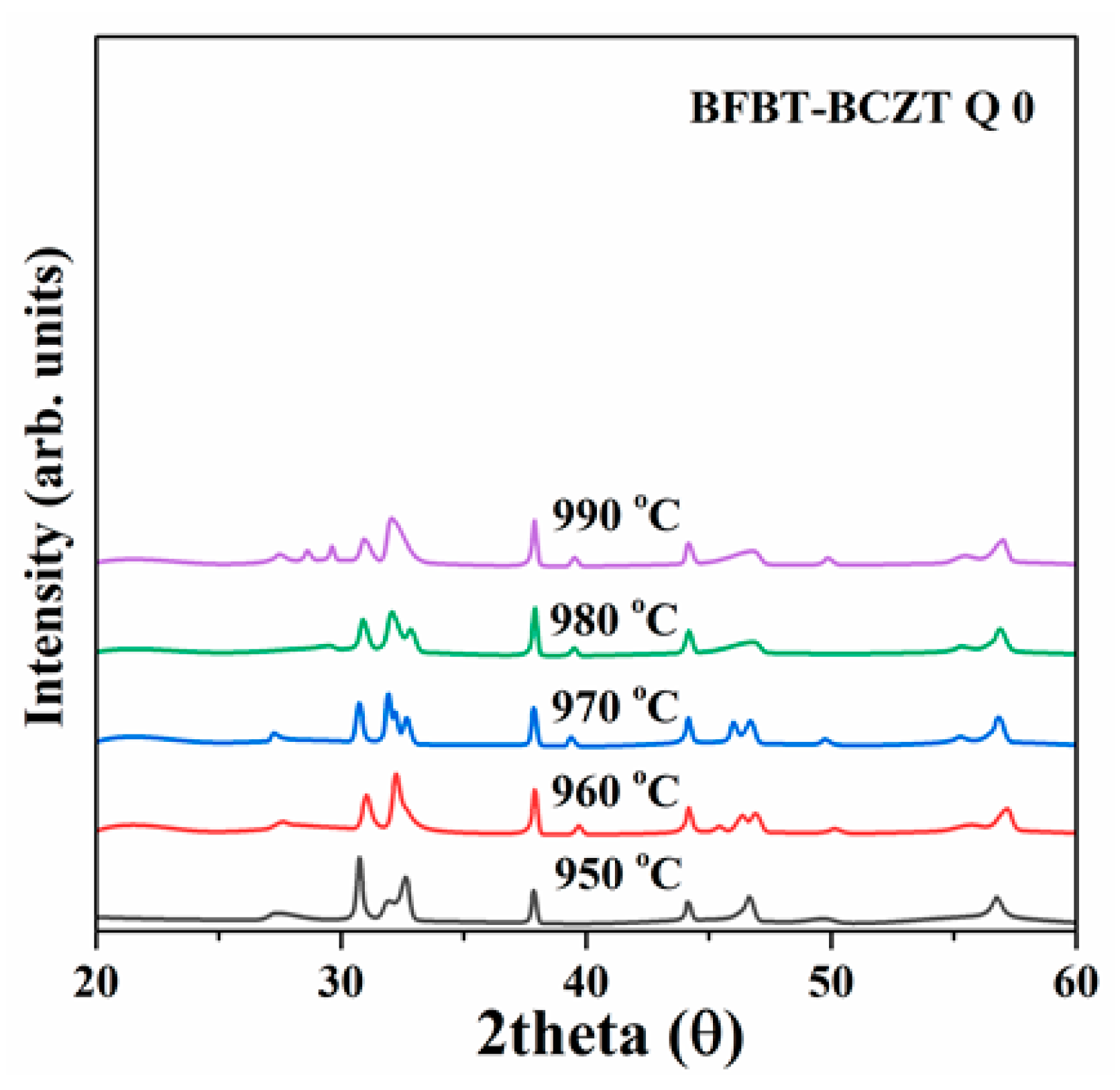
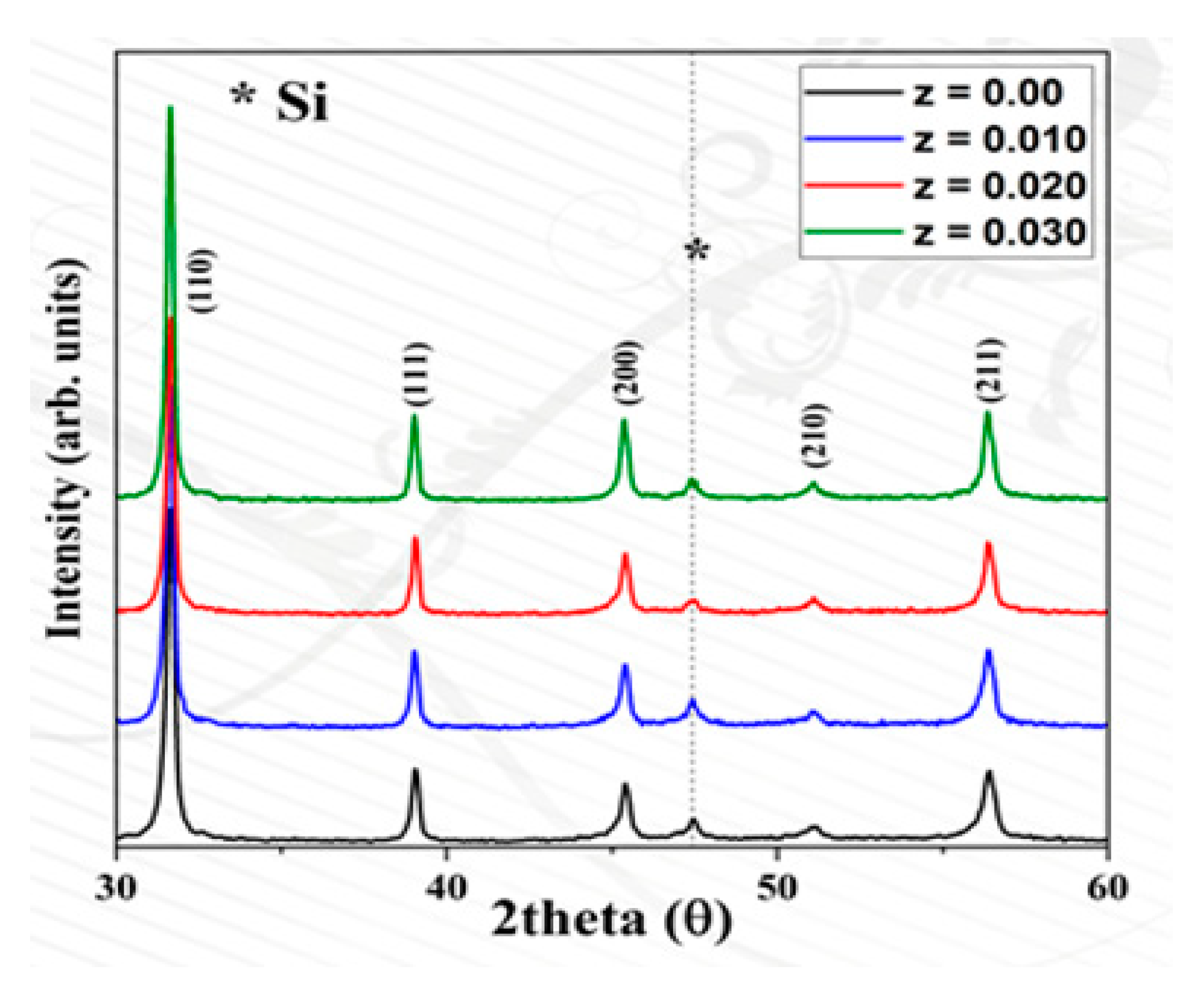
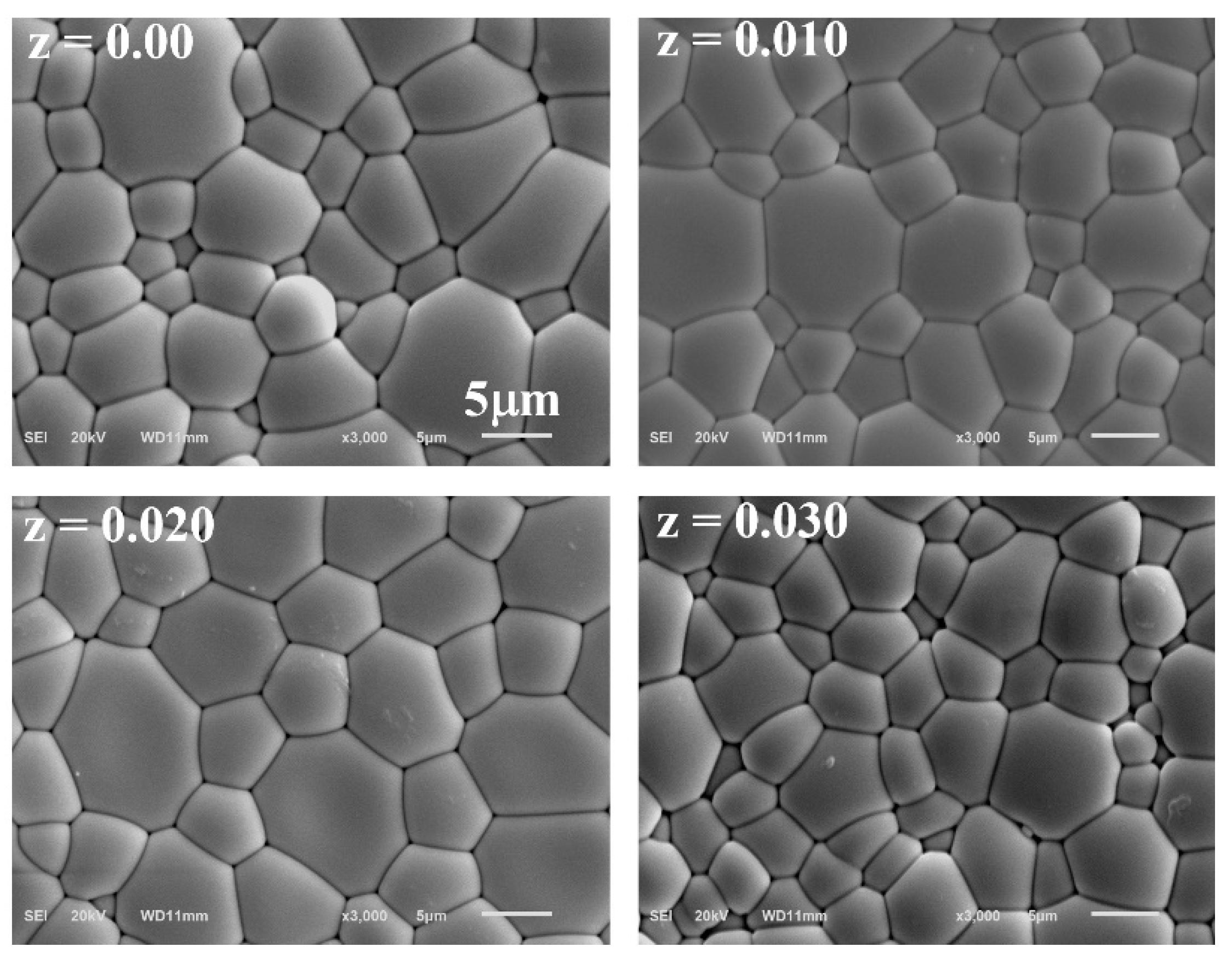
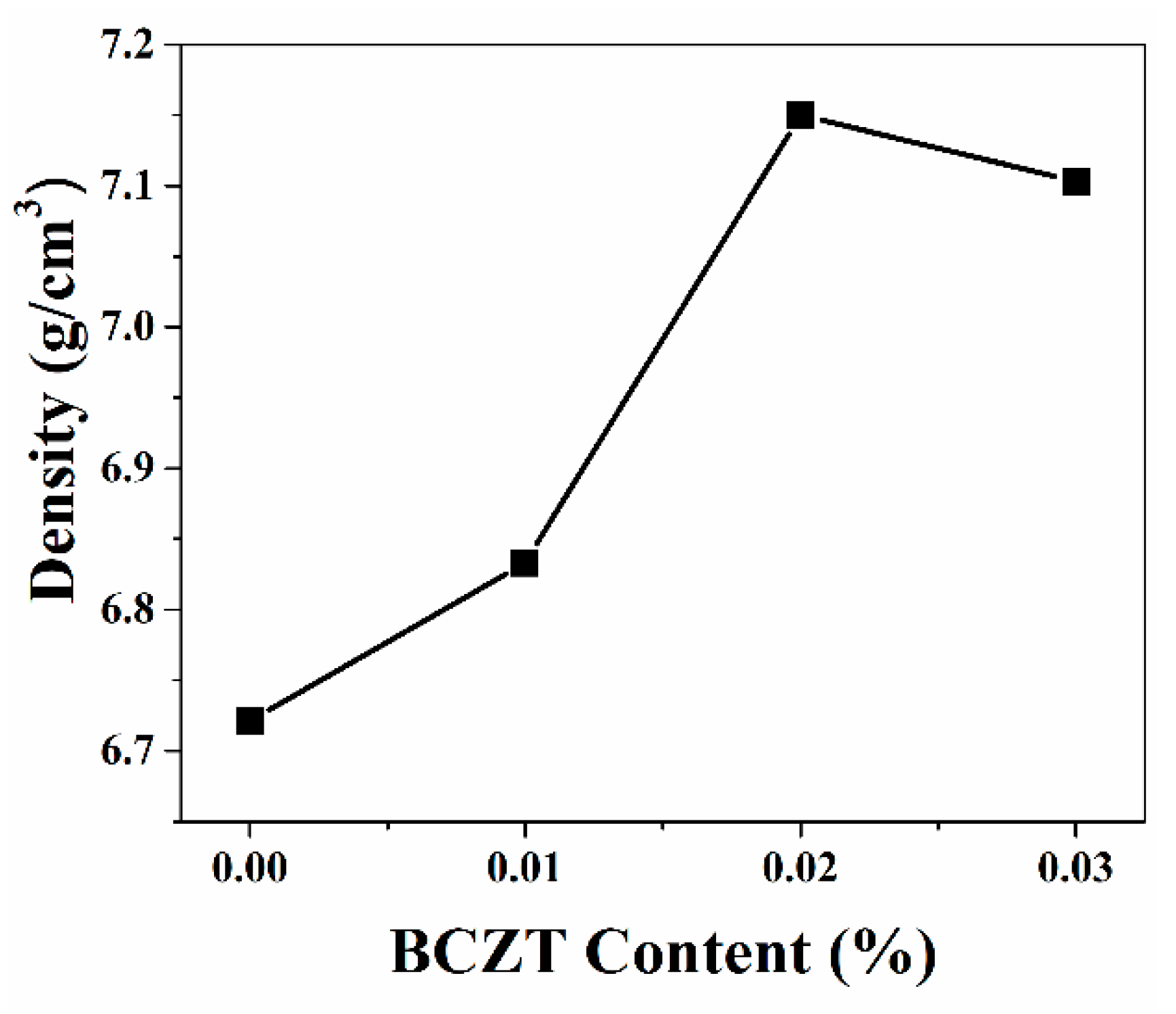
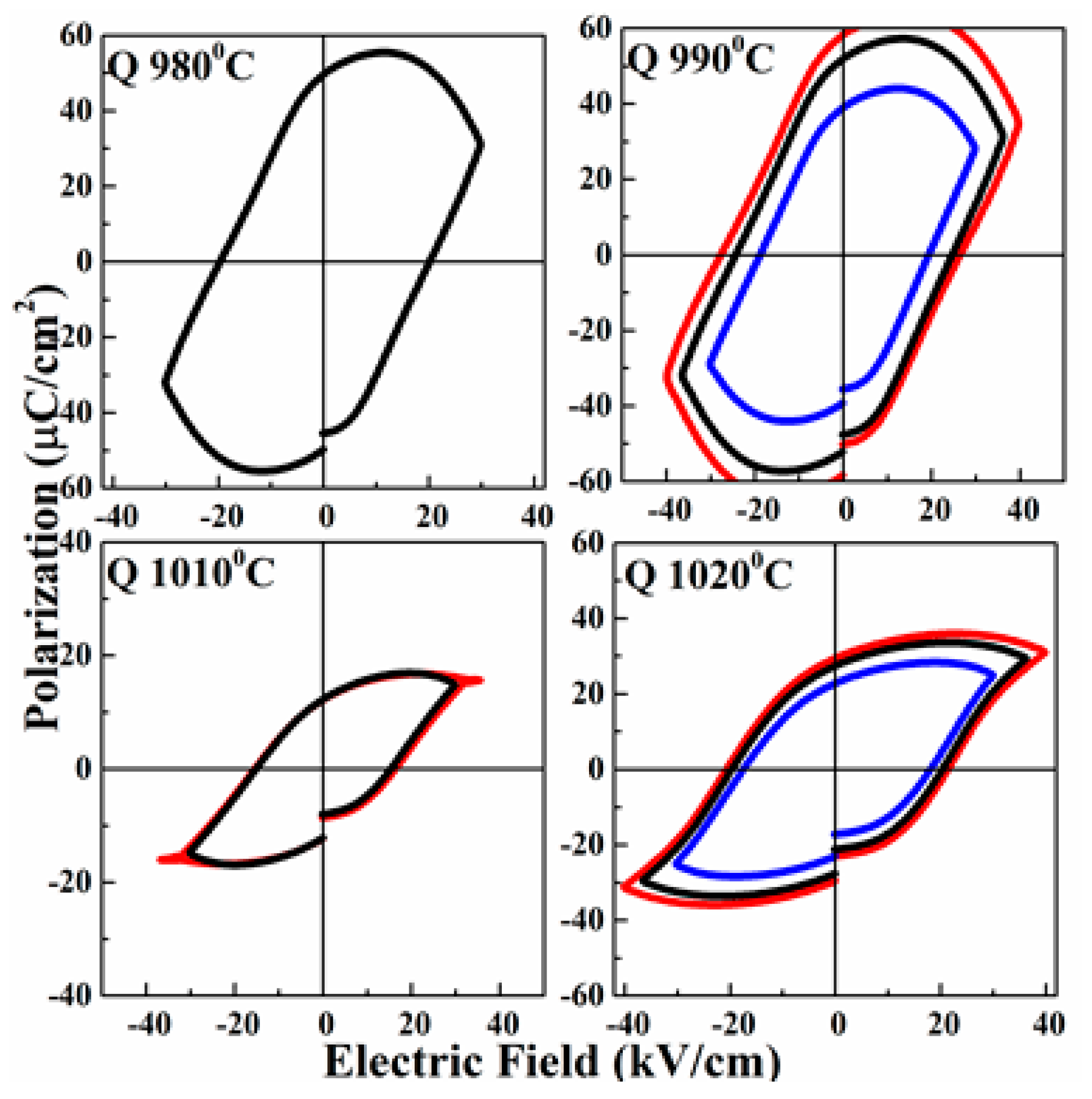
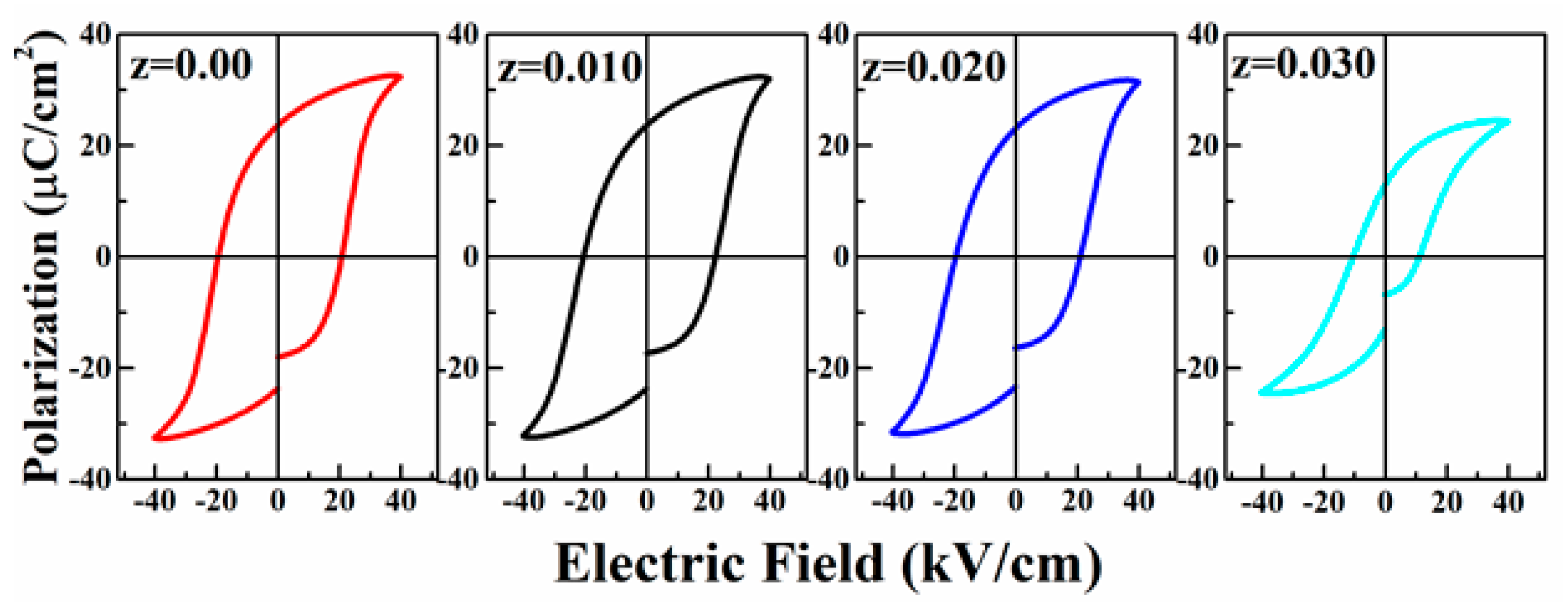
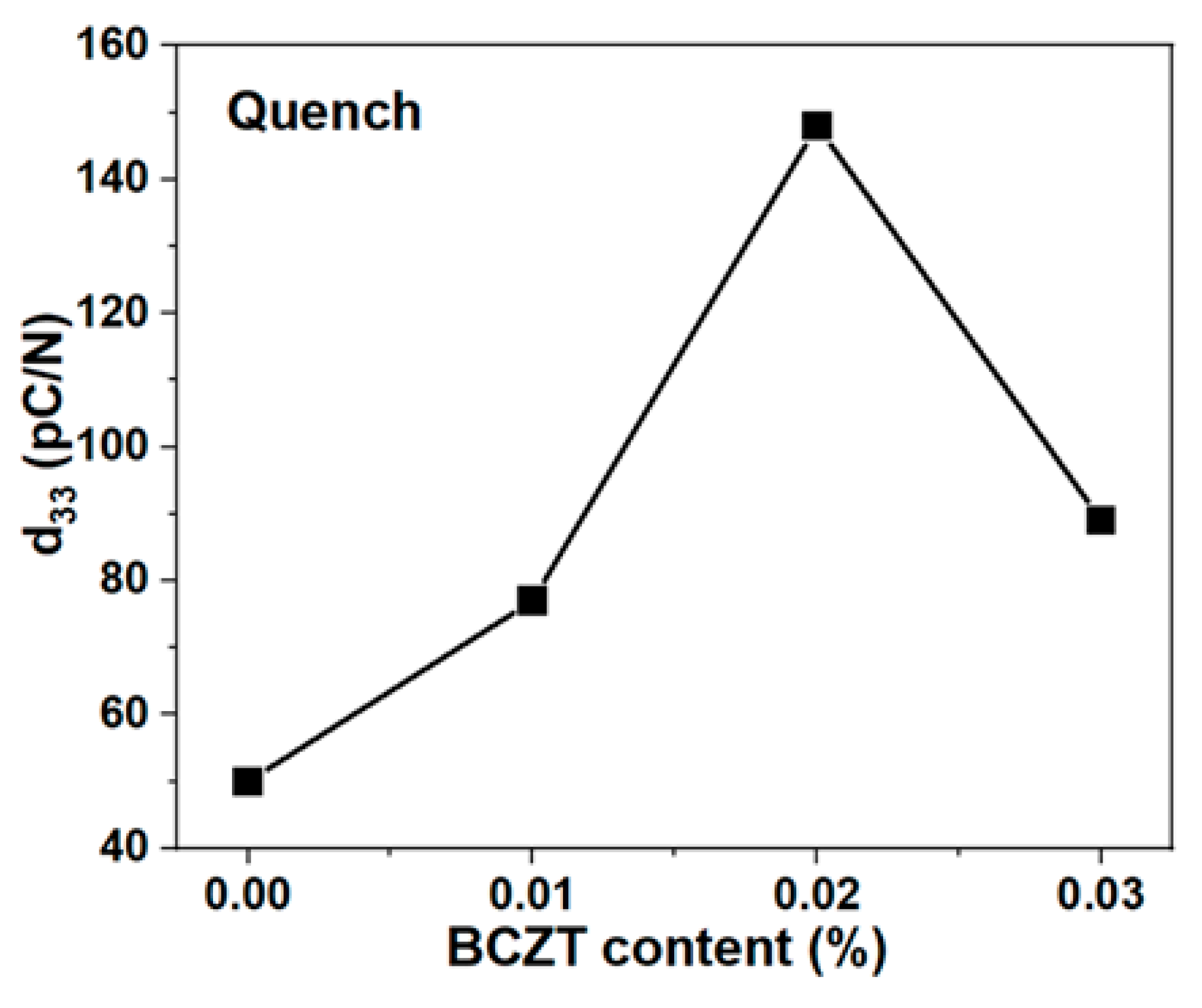
| Materials | d33 (pC/N) | Year | References |
|---|---|---|---|
| BiFeO3–BaTiO3–Bi0.5K0.5TiO3 | 135 | 2013 | [35] |
| 0.65BFGa–0.35BT | 145 | 2018 | [36] |
| 0.675BF-0.325BT-xLT | 145 | 2018 | [37] |
| 0.75B0.975Nd0.025F–0.25BT+Mn | 140 | 2018 | [38] |
| 0.73BF–0.25BT–0.02LCM + Mn | 108 | 2015 | [39] |
| 0.99(0.67BF–0.33BT)–0.01LN | 146 | 2017 | [40] |
| 0.60BF–0.40BT–0.02BZT | 50 | 2017 | [41] |
| 0.75BF–0.25BT | 47 | 2009 | [42] |
| 0.65Bi1.05Fe1−xGaxO3–0.35BaTiO3 | 140 | 2019 | [43] |
| BF–BT–BCZT | 152 | 2021 | Current Work |
Publisher’s Note: MDPI stays neutral with regard to jurisdictional claims in published maps and institutional affiliations. |
© 2021 by the authors. Licensee MDPI, Basel, Switzerland. This article is an open access article distributed under the terms and conditions of the Creative Commons Attribution (CC BY) license (https://creativecommons.org/licenses/by/4.0/).
Share and Cite
Malik, R.A.; Alrobei, H. Processing and Characterization of BCZT-Modified BiFeO3-BaTiO3 Piezoelectric Ceramics. Crystals 2021, 11, 1077. https://doi.org/10.3390/cryst11091077
Malik RA, Alrobei H. Processing and Characterization of BCZT-Modified BiFeO3-BaTiO3 Piezoelectric Ceramics. Crystals. 2021; 11(9):1077. https://doi.org/10.3390/cryst11091077
Chicago/Turabian StyleMalik, Rizwan Ahmed, and Hussein Alrobei. 2021. "Processing and Characterization of BCZT-Modified BiFeO3-BaTiO3 Piezoelectric Ceramics" Crystals 11, no. 9: 1077. https://doi.org/10.3390/cryst11091077
APA StyleMalik, R. A., & Alrobei, H. (2021). Processing and Characterization of BCZT-Modified BiFeO3-BaTiO3 Piezoelectric Ceramics. Crystals, 11(9), 1077. https://doi.org/10.3390/cryst11091077






